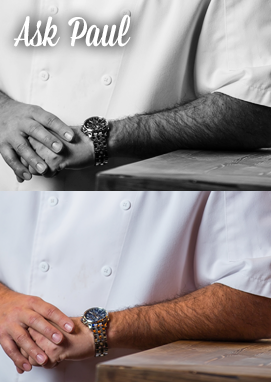Pork medallions in mushroom sauce a chef favourite
Tuesday, November 27You might think that having a pantry full of food would allow us chefs to feast on the likes of tenderloin and lobster tails night after night. Well, you’d be wrong. The reality is that the restaurant business is one of the smallest profit margin businesses out there.
In fact, a recent study I read said that the average full service restaurant in 2011 managed to muster up a meager 1.8% profit, which makes it easy to understand why more than 60% of restaurants fail in the first three years.
With that painfully low margin of profit, it is imperative that every morsel of food gets used. So, while diners are feasting on course after course of epicurean delight, the chef is watching every morsel of food and ensuring nothing goes to waste. That leaves the cooks to prepare a much more modest meal, using whatever morsels and bits the chef has so graciously agreed to set aside for the staff meal.
I was first introduced to the idea of the staff meal while working at a large hotel in Banff.
Starting there as a young cook with little experience, I had to work my way through all departments of the kitchen, and that included being responsible for feeding the 100-plus staff members every shift I worked. Feeding a group that large on a shoestring budget had its fair share of challenges, but it also provided a great opportunity to learn to be creative and resourceful.
Sometimes it was beef trimmings as the butcher prepared the cuts of beef for the guests, other times it was leftover roast lamb from a buffet prepared the previous night.
Whatever it was, I had to find a way to make it tasty and nourishing for the masses as they piled into our basement cafeteria for a much needed break from their day. Quickly it began to feel less like a pleasure and more like a chore to feed the herd and keep them happy. Seldom did we actually get to sit and join the rest of the team for a meal. It didn’t exactly leave me with the fondest memories of the daily gathering.
It wasn’t until I arrived in Switzerland that I found an appreciation for this restaurant ritual. It was there that I saw this opportunity in a whole new light. There were only about a dozen of us working in the kitchen together and we spent a lot of time together, arriving most days around 8 a.m., and not usually leaving until 10 or 11 at night. The two staff meals we shared together every day allowed for us to unwind from the seemingly endless prep lists and refocus for the busy service to come.
It was also a chance for each of us young cooks to create something different for our cohorts. There were never a shortage of scraps and odds and ends to cook with either. The list was varied and changed with the seasons, much like our menu. Sometimes the chef would order a little too much fish, so it was quickly snatched up for sole a la meuniere. Other times it was trimmings from a veal loin that was sautéed with some vegetables and finished with a curry cream sauce. One day I even prepared a classic American mac n’ cheese for the team.
I even grilled off some bratwursts and threw them in. I’m not sure the Europeans shared my great enthusiasm for a little comfort food that I did. Something must have been lost in the translation. Then there were the days when we were deep in the grips of winter. That all too often meant the staff meal consisted of platters full of offal, also known as organ meat.
Boiled beef tongue or heart, honeycomb tripe, and crispy fried sweetbreads were just a few of the choices. Now I certainly have a great appreciation for chefs who can prepare these less than desirable organ meats into something that passes for edible, but I have a hard time swallowing some of these dishes, literally!
Despite the few shifts where I had to stomach a tough meal like that, I always looked forward to those few moments each day, shared amongst my peers. For a guy who was so far away from home, it felt as close to family as I could get.
I always enjoyed the rare day when we were blessed enough to have some actual pork or veal medallions to cook with. Sometimes they were breaded and made into schnitzel or picatta, but my absolute favourite was when we got to use some chicken or veal veloute to prepare a rich, creamy mushroom sauce to slather over seared medallions. I would lap up that sauce as though it were my last meal each and every time.
So, with that in mind, I share with you my take on one my favourite staff meals that we used to enjoy whenever we could. This is a fantastic dish to enjoy over handmade pasta, like fresh tagliatelle, or some delicious fresh Stone Ground Mustard Spaetzle. Head to my facebook page, www.facebook.com/chefshufelt where I share the secret recipe for one of my most memorable dishes from my time in Switzerland. It’s the perfect accompaniment to this tasty use of pork.
Pork Medallions in Mushroom Cream Sauce
Feeds: 4
Prep time: 15 minutes
Cooking time: 30 minutes
1 Tbsp. butter
1 Tbsp. flour
½ litre chicken stock
½ cup white wine
½ cup heavy cream
2 Tbsp. minced shallots
1 Tbsp. minced garlic
1 Tbsp. fresh thyme
1 cup fresh mushrooms, sliced
1.5 lbs. pork loin or tenderloin medallions, ½ inch thick
4 Tbsp. canola oil
In a medium thick bottomed sauce pot melt the butter
Quickly add the flour and stir in the flour with a whisk
Continue to cook over medium heat, while stirring, until the flour and butter is well combined and begins to lightly brown, you have now made a roux, the thickening agent for our sauce
Quickly add the chicken stock and whisk vigorously as you bring it to a simmer
Allow to simmer for 10-15 minutes, stirring regularly as the sauce begins to thicken
As your sauce is thickening, it’s time to prepare the pork
Heat a large deep sauce pan to high heat, using 2 tbsp. canola oil, season and saute the pork medallions, browning one side, then flipping and browning the other side, then remove and set aside, be sure not to overcrowd the pan, as this will cause the meat to steam rather than sear
Now, using the other 2 tbsp. of canola oil, saute the shallots and garlic, then quickly add the mushrooms and saute until lightly browned
Deglaze the pan with the white wine, lightly scraping the bottom of the pan to extract all of the great caramelized flavours
Once the white wine has reduced by half, add your sauce that you have prepared into the mushrooms and bring to a simmer
Add the cream and fresh chopped thyme to the pan and stir to combine
Return the pork to the pan and heat through
Adjust the seasoning of the sauce and then serve over your favourite starch
Who’s hungry?



